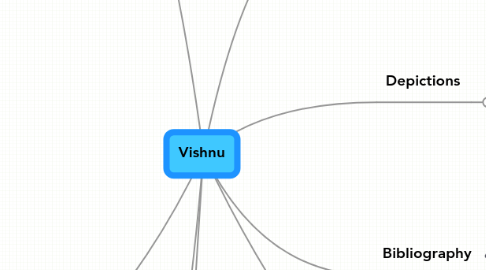
1. Appearance
1.1. blue-skinned
1.1.1. nature is a infinite as the sky
1.2. four arms
1.2.1. The physical existence of Vishnu is represented by the two arms in the front while the two arms at the back represent his presence in the spiritual world.
1.2.2. his all-powerful and all-pervasive nature.
1.2.3. north, south, east, west
1.2.4. New node
1.3. Discus
1.3.1. represents the spinning universe
1.3.2. held by upper right hand
1.3.3. represents purified spiritualized mind
1.3.4. burns away the spiritual ignorance and illusion
1.3.5. also called chakra or "Sudarshana"
1.3.5.1. "Su" means good, superior
1.3.5.2. "Darshan" means vision or Sight; together it is "Superior Vision
1.3.6. destruction of ones ego
1.4. Golden Mace
1.4.1. held by lower left hand
1.4.2. symbolizes Vishnu's divine power is the source all spiritual, mental and physical strength.
1.4.3. signifies Vishnu's power to destroy materialistic or demoniac tendencies
1.4.4. Vishnu's mace is the power of the Divine within humans to spiritually purify and uplift them from their materialistic bonds
1.5. conch seashell
1.5.1. held by the upper left hand
1.5.2. represents Om, the sound from which the universe manifested.
1.5.3. water, fire, air, earth and sky or space.
1.5.4. represents the five airs or Pranas that are within the body and mind.
1.5.5. symbolizes that Vishnu is the primeval Divine sound of creation and universal maintenance.
1.6. often shown reclining or asleep as he awaits the next annihilation and renewal of the world
1.7. Lotus
1.7.1. held by lower right hand
1.7.2. represents spiritual liberation, divine perfection, purity
1.7.3. The lotus opening its petals in the light of the Sun is indicative of the expansion and awakening of our long dormant
1.7.3.1. symbolizes that god is the power and source from which the universe and the individual soul emerges.
1.8. Eyes
1.8.1. left eye: dark, symbolic of the night
1.8.2. right: light, symbolic of the day
1.9. earrings
1.9.1. He is to shown wearing two earrings: The earrings represent inherent opposites in creation — knowledge and ignorance; happiness and unhappiness; pleasure and pain.
1.10. Snakes
1.10.1. infinity- symbols of the ocean, from which creation emerged and where it will return
2. Lakshmi
2.1. goddess of fortune
2.2. appeared with all of Vishnu's incarnations
2.3. Two of the most famous prayers for worshipping Ma Lakshmi are Sri Lakshmi Stuti and Sri Sukta.
3. Vaishnavism
3.1. Shiva, the main God of many Hindus is only a servant of their god Vishnu
3.2. The followers of Vaishnavism are referred to as Vaishnavas or Vaishnavites
3.3. includes the central beliefs of Hinduism such as reincarnation, samsara, karma, and the various Yoga systems
3.3.1. the ultimate goal of Vaishnava practice is an eternal life of bliss
4. Garuda
4.1. large mythical bird or bird-like creature that appears in both Hindu and Buddhist mythology
4.2. the mount of Vishnu
4.3. Appearance
4.3.1. Golden body
4.3.2. white face
4.3.3. red wings
4.3.4. eagle's beak
4.3.5. strong man's body
4.3.5.1. wears a crown on his head. He is ancient and has size enough to block out the sun.
5. God
5.1. supreme
5.1.1. God of the past, present and future, the creator and destroyer of all existences, one who supports, sustains and governs the Universe and originates and develops all elements within.
5.2. preserver of the world
5.3. takes on a human form when things are bad and fixes them
5.4. animals are constantly fighting to show the opposite forces that make the happy middle of Vishnu.
6. Avatars
6.1. Matsya
6.1.1. incarnated himself as a fish
6.1.2. similar to Joan of Ark story
6.1.3. After the world was flooded, Vishnu created the new era
6.2. Kurma
6.2.1. incarnated himself as the tortoise
6.2.2. held up Mt. Mandara on his back
6.3. Varaha
6.3.1. incarnated himself as the boar
6.3.2. saved the Vedas after they were stolen from Lord Brahma by the demon Hiranyaksha
6.4. Narasimha
6.4.1. incarnated himself as a half man-half lion
6.4.2. killed the demon Hiranyakasyapa
6.5. Vamana
6.5.1. incarnated himself as a dwarf priest
6.5.2. crushed the greedy Bali
6.6. Parasurama
6.6.1. incarnated himself as a brahmana (priest)
6.6.2. avenged all the kshatriyas who had become arrogant and were suppressing the brahmans in the world.
6.6.2.1. A kshatriyas was a member of the second highest of the four castes of traditional Indian society, responsible for upholding justice and social harmony, and including people in governing and military positions.
6.7. Rama
6.7.1. incarnated himself as Rama
6.7.1.1. Rama is a deified hero worshiped as an incarnation of Vishnu.
6.7.2. spends 14 years in the forest, with wife SIta
6.7.3. one version he kills his wife, the other he rescues her from a demon and they return to Ayodhya and rule for 1000's of years
6.8. Krishna
6.8.1. incarnated himself as Krishna
6.8.1.1. Krishna is the central character in the epic Mahabharata
6.8.2. about a war
6.9. Buddha
6.9.1. incarnated himself as Buddha
6.9.1.1. Buddha is the ascetic prince who renounced the throne to lead the world on the path of peace.
6.9.1.1.1. founder of the Buddhist religion prominent across the world
6.9.2. he left his wife and children to a hermit's life in the forest, where he eventually became the "enlightened one".
6.10. Kalki
6.10.1. incarnated himself as Kalki
6.10.2. rides a white horse with a blazing sword
6.10.3. At the end of the present era, it is said that he is going to punish all evil doers in this world, destroy this world supposedly and recreate a golden age again.
7. Depictions
7.1. standing on a lotus flower
7.1.1. often accompanied by Laksmi
